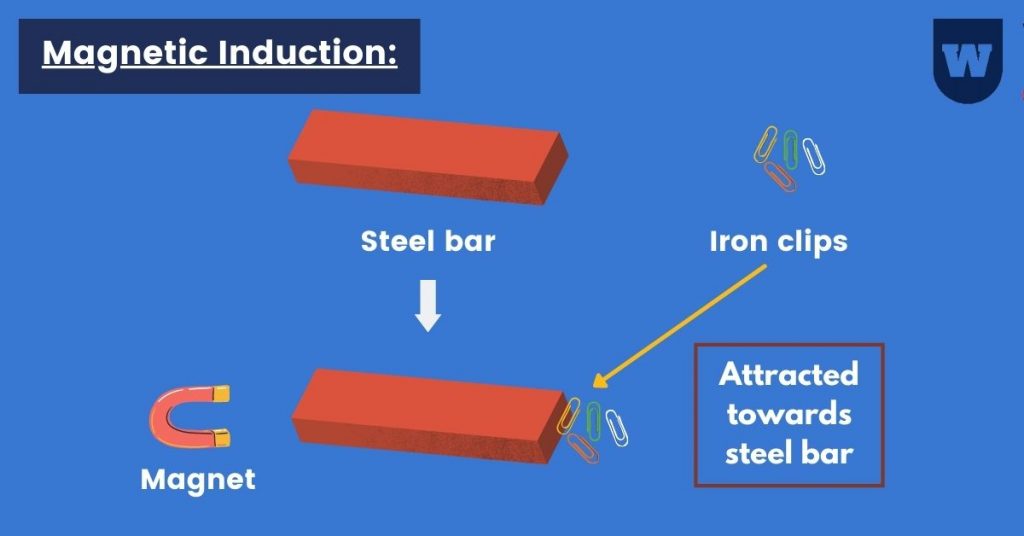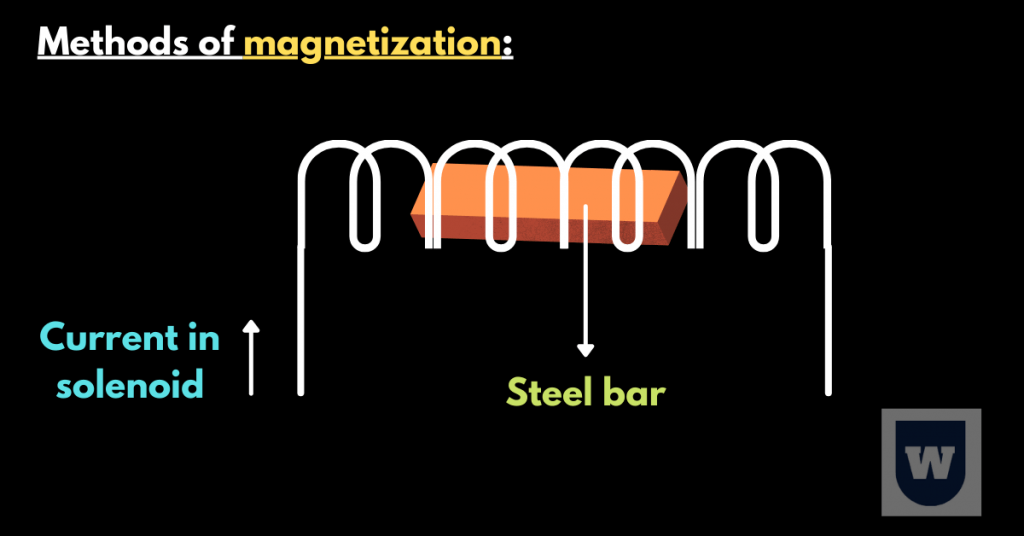If you want easy-to-understand notes on magnetism and electromagnetism, you will love this comprehensive resource I am about to share with you.
In fact, these are the exact notes I used to understand this topic (easily).
So keep reading.
Magnetism:
Have you ever heard about attraction or repulsion? In simple words, this is magnetism.
Let me explain how.
In Physics, magnetism is the phenomenon that causes attraction and repulsion between objects (due to electric charges).
If these terms are confusing you, do not worry. I will explain all these terms to you in detail.
But for now, here is what you should know:
Magnetic materials are those materials that are attracted to a magnet (due to their magnetic properties). Some examples are:
- Cobalt
- Nickel
- Iron (and their alloys etc)
On the other hand, the materials that are not attracted by a magnet are called non-magnetic materials. Some examples are:
Rubber, water, plastic, gold, and silver, etc.

Before moving on, here are some properties of magnets you should know as well:
Properties of Magnet:
- Attractive property: Note that a magnet attracts ferromagnetic materials (that are easily magnetised like Iron).
(Opposite poles attract, such as North-South or South-North).
- Repulsive property: Like (same) poles (such as North-North or South-South) repel each other.
- Directive property: Note that a freely suspended magnet points in the North-South direction. This is the exact reason we use magnetic as compasses as well.
Note: Let’s suppose there are two materials. One material (X) gets attracted to a magnet, but the second material (Y) repels the magnet. Which material is a magnet?
The material Y is magnetic because repulsion is a test of magnetism.
Magnetic Induction:
Have you ever heard about iron or steel getting magnetized? Well, that is magnetic induction.
In simple words, magnetic induction is a process by which substances (such as steel or iron) get magnetized by a magnetic field.
Let’s take a look at an example to further understand this topic.
Example: Let’s suppose that you have a steel bar at the centre, with a magnet on its right side and some clips on its left.
What will happen?
You will notice that the clips get attracted to the steel bar (even though it is not a magnet). But why?

The answer is magnetic induction. Here is what happens.
The magnet on the right side has a magnetic field that causes the steel bar to get magnetized. As a result, the clips get attracted to this steel bar.
If you take the magnet away, the clips will no longer be attracted because the steel bar will lose its magnetic properties (as it will no longer be induced).
When discussing this topic, there is an important concept you need to know.
Iron is a good temporary magnet (as it gets magnetized and demagnetized easily). On the othet hand, steel is a good permanent magnet (it gets magnetized and demagnetized slowly).
Methods of magnetization and demagnetization:
After studying the topic of magnetic induction, you may have this question: Are there any ways we can magnetize an object?
The answer is, yes! Here are a few methods of magnetization:
- The “Stroking method“:
If you have a bar of steel and a (bar) magnet, you can magnetize the steel bar. Here’s how.
The steel bar is stroked with the same pole of the permanent magnet from one end to the other (in one direction). This stroking multiple times will magnetize your steel bar.
Note: You can use two (permanent) magnets for this method as well. But, you will have to ensure that both magnets are stroked in the opposite direction (and have the opposite poles).
Here is what I mean. If one magnet has the North pole (and is struck from the left), then the second magnet should have the South pole (and should be struck from the right).
With that being said, it is time to move on to the second method of magnetization that is the electrical method.
- The electrical method:
This process is pretty simple. Here is what is done:
If you have a bar of steel or iron (to be magnetized), simply connect a solenoid (a coil with multiple turns) to a D.C supply (current flows in one direction only).

Then place the iron bar in the solenoid and turn on the D.C power supply. When the current flows through the solenoid, a magnetic field is produced (due to the current).
This magnetic field causes the iron bar to be magnetized.
Simple, isn’t it?
Further reading:
Dynamics (Forces) | O Level Notes
Light Made Simple | Best Notes
Current Electricity | Complete Notes
Now, let’s discuss some methods of demagnetization.
- Hammring (or by dropping the magnet from a height):
Before understanding this concept, you need to know about the magnetic domain.
A magnetic domain is a region where magnetic moments align in the same direction. This alignment allows the material to stay magnetized.
However, hammering disturbs the magnetic domain and the alignment breaks as well. As a result, the material gets demagnetized. In the same way, dropping a magnet from a height (continually) also disturbs its alignment (magnetic domain).
Now, let’s talk about heating.
- Heating:
Do you know that heating the magnet (over a particular temperature) can also demagnetize it?
If you heat the magnet past the Curie point (temperature above which the magnet becomes demagnetized), the magnet will start losing its magnetic properties.
Here’s why.
Due to heating, the magnet faces a reduction in the magnetic field as the particles gain energy and move faster. This movement causes the magnetic domains to misalign (causing the magnetism to reduce).
This is the reason why heating can also cause demagnetization.
- Electrical method (using A.C supply):
Do you remember the electrical method (that was previously discussed)? It is the same but has some slight differences.
First of all, we connect a solenoid with an A.C supply. Then, the magnet is placed inside the solenoid and the A.C power supply is turned on.
We then slowly withdraw the magnet from the solenoid (as the current is still flowing). This action causes the magnetic to be demagnetized.
Note: This is because the A.C current changes its direction multiple times. As a result, the magnetic domain of the magnet is disturbed. This is the reason why it gets demagnetized.
These were some details about the topic of magnetism. Now, let’s take a look at electromagnetism in detail.
Electromagnetism:
In simple words, this is a process through which we create a magnetic field by passing a current (in the conductor).
So in this topic, I will be explaining some important concepts to you such as:
- The right-hand rule
- The left-hand rule
- DC Motor
So let’s start.
The right-hand rule:
As I said earlier, we can create a magnetic field by passing a current through a conductor. But, how can we find out the direction of the current or the magnetic field?

For that, we use the right-hand rule. And here is what it says:
If you point your thumb in the direction of the current, then your (curled) fingers will indicate the direction of the magnetic field.
Here are some other concepts related to this rule:
- If the direction of the current is reversed, then the direction of the magnetic field will also be reversed.
- The strength of the magnetic field (in a conductor) increases as the current in it increases.
- In a solenoid (a conductor with multiple turns), increasing the number of turns increases the magnetic field (as the current flows through it).
Moreover, if you place a soft iron core within a solenoid, the strength of the magnetic field will also increase. Can you guess the reason for this?
Forces between parallel current-carrying conductors:
You should know that:
- Current carrying conductors in opposite directions repel.
- Current carrying conductors in the same direction attract.
(The diagram below summarises this information):

With this, it is time to talk about Fleming’s left-hand rule and the motor effect.
Fleming’s left-hand rule:
This concept is pretty simple but important. But what does it say? Let me explain.
We can use this method to find the force on a conductor (in an electric motor) if we know the direction of the magnetic field and the current.
Basically, we use our thumb, index finger and middle finger:
Thumb: It represents the direction of the force (motion) on the conductor.
Index finger: It indicates the direction of the magnetic field.
Middle finger: It represents the direction of the current.
The Motor effect:
When talking about the left-hand rule, we have to discuss the motor effect.
A current-carrying conductor can apply force on a (permanent) magnet. This is called the motor effect.
Note: It is the motor effect that allows an electric motor (DC motor) to operate. Here is how it is done.
In a simple DC motor, we have stationary magnets and a coil of wire (carrying current). This current produces a magnetic field as well.
The point to note over here is that a force is applied on the coil (due to the current and the magnetic field) that allows it to rotate. The step-by-step guide summarises all this:

- An electric current flows through the wire.
- On the South pole of the magnet, an upward force acts that cause the wire to move up.
- Due to this, the coil of wire rotates on an axis.
- When the coil reaches the vertical position, the current stops flowing but it rotates due to inertia.
After the vertical position, the current continues to flow and the process continues.
Applications of electromagnetism:
Have you ever heard about a circuit breaker or an electric bell? Well, these are some everyday applications of electromagnetism.
Circuit breaker: It is an (automatic) switch that opens (stops the current from flowing) when a large current passes through it. Here is what happens.
When the current increases, the strength of the electromagnet will also increase. Due to this, a soft iron armature gets attracted towards the electromagnet.
As a result, the contact is pulled apart by the spring and the circuit is disconnected (immediately). When this happens, the current stops flowing (as the path is blocked).
This is how we use circuit breakers to protect our appliances from damage.
Loudspeakers: These devices operate by the “motor effect”. Here’s how.
Basically, a variation (change) in the current also causes a change in the electric field (produced by the electromagnet). Due to this, the “cone” in the loudspeaker moves that causes pressure changes in the air.
As a result of these pressure variations, sound waves are formed.
In short, here is what happens:
- A current (AC supply) in the coil produces a magnetic field.
This magnetic field interacts with the permanent magnet. As a result, a force is produced that pushes the cone outward.
- Now, the current flows in the opposite direction.
Now an inward force acts on the cone.
This repeated movement of the current causes the cone to move forward and backwards.
- These vibrations result in pressure changes that ultimately produce sound waves.
Simple, isn’t it?
Wrapping up:
With this, the topic of magnetism and electromagnetism has been covered.
Now, I have a question for you.
Which part of this topic do you find the most interesting. Or there are some concepts you find challenging? Either way, do let me know in the comments below.
You should practise plenty of past paper questions for this topic as it is important from an examination point of view.
Thank you very much for reading and staying with me till the end. Stay tuned for more.
.
